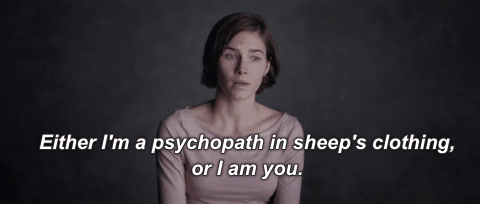Amanda Knox, Netflix and the making of white innocence
Amanda Knox, Netflix and the making of white innocence

I am mainly interested in psychoanalysis as an ethnography of the white psyche — after all, the concepts of self and other that came into being in psychoanalysis were dependent on the politics of colonial relations. Gloria Wekker — White Innocence
This weekend I watched the new Netflix documentary “Amanda Knox”. It’s been almost 48 hours since I watched it and there are many issues that have stayed with me since. I have been reading reviews and while they have been mostly favorable they’ve also been lacking. When a media product stays with me, in a sort of nagging, pressing way, it usually means I need to flesh out the reasons of my discomfort. A discomfort that has been exacerbated by the reviews as well. So here we are.
First, I’d like to start by getting a few things out of the way: I am not interested in discussing Amanda Knox’s innocence or guilt in relation to the crime she was accused of. I am mostly interested in Amanda Knox (the documentary in question) as a media artifact, a production that seeks to address a real topic while entertaining an audience. I will say, though, that I found the media treatment of Amanda Knox (the person, not the documentary) despicable. The details of her life (many simply untrue) turned into a lurid, morbid spectacle were a disgusting low point in misogynist media.
Here is what has been piercing me since watching this documentary: not once during the film were the words “white” or “whiteness” used. Twenty minutes or so into watching, I went back to the beginning of the documentary to see if I had missed something. From that moment on, I waited. Needless to say, I waited for nothing. The absence of “whiteness” as a framework, came at me like a brick when the images of Arline Kercher, Meredith Kercher’s mother were shown.

I realized then that I was watching a portrayal of “white innocence” in the making.
In her book White Innocence, Professor Gloria Wekker writes:
In sum, innocence speaks not only of soft, harmless, childlike qualities, […]; it is strongly connected to privilege, entitlement, and violence that are deeply disavowed. Loss of innocence, that is, knowing and acknowledging the work of race, does not automatically entail guilt, repentance, restitution, recognition, responsibility, and solidarity but can call up racist violence, and often results in the continued cover-up of structural racism. Innocence also includes the field that has become the center of my explorations: sexual racism. There is denial and disavowal of the continuities between colonial sexuality and contemporary sexual modalities.
Now, I do not mean that the portrayal of “white innocence” was intended in the criminal justice system sense (though it does that as well) but in the sense of whiteness as a system by itself. Here is this white woman, Amanda Knox, accused of the murder of another young woman, one whose mother is visibly non white (Arline Kercher was born in Pakistan and raised in India).

The accused, to deflect her guilt, points to Patrick Lumumba, a Black man, as the culprit. The politics of this entanglement are not mentioned once. Not even in passing. It didn’t escape me that the two directors of the film, Rod Blackhurst and Brian McGinn are white men (there is even an archival footage cameo of Donald Trump calling for a “boycott of Italy”).
In the opening of the film, to explain why what happened to her was an injustice, Amanda Knox says “Either I am a psychopath in sheep’s clothing or I am you” and again, I found myself wondering who this “you” is. Because this narrative only works if the “you” is meant to be white and of a certain class and education. The only way that this film can cause identification with Amanda Knox is if the “you” is a fellow white person terrified by the miscarriage of justice because “omg it can happen to “us” as well!”. There is not a single mention of how miscarriages of justice disproportionately affect people of color, not even when Ms. Knox mentions that she now works as an advocate for the wrongly convicted. Instead, we are treated to an hour and a half of “white fear”. Injustice, the documentary seems to imply, is not just for “those people”. And of course, the glaring omission of the (white) elephant in the room: when the she was under severe pressure, she deflected by pointing to the person that in Western imaginations already carries the stigma of the stereotypical over sexualized other: the Black man. Needless to say, this action is not coded as a miscarriage of justice by itself. The filmmakers, instead, stress on how afraid she was, how she was pressured by the Italian authorities to confess to a crime she did not commit, etc. There isn’t a single interrogation of why she might point to a Black man or the already precarious situation of Black migrants in Italy, often targets of racist violence. Instead, and this is the “slip” that gives away the racist mechanism in the film, she says “she was under so much pressure that she imagined, perhaps even dreamed of Lumumba at the scene of the crime”. For centuries, white imagination has always placed the Other at the scene of the crime.

The filmmakers constantly imply that we should be indignant on behalf of Amanda Knox. Indignant that this miscarriage of justice and exploitative media portrayal was allowed to happen under our watch. Indignant that it took so long to correct these wrongs and that her life will never be the same. I waited, in vain, for the moment that they would also imply that we should be indignant that white imagination is so deeply rooted in centuries old racism that she pointed to an innocent man to deflect the pressure she was in. Instead, I got plenty of teary eyed declarations. After all, this documentary wasn’t as much about justice for a murder victim or the wrongly convicted as it was about the construction of white innocence. A white innocence that simply dreams of the Other at a crime scene and the prices the Other pays for being unwitting participants in those dreams.
For the past decade and a half I have been making all my content available for free (and never behind a paywall) as an ongoing practice of ephemeral publishing. This site is no exception. If you wish to help offset my labor costs, you can donate on Paypal or you can subscribe to Patreon where I will not be putting my posts behind a lock but you'd be helping me continue making this work available for everyone. Thank you. Follow me on Twitter for new post updates.

